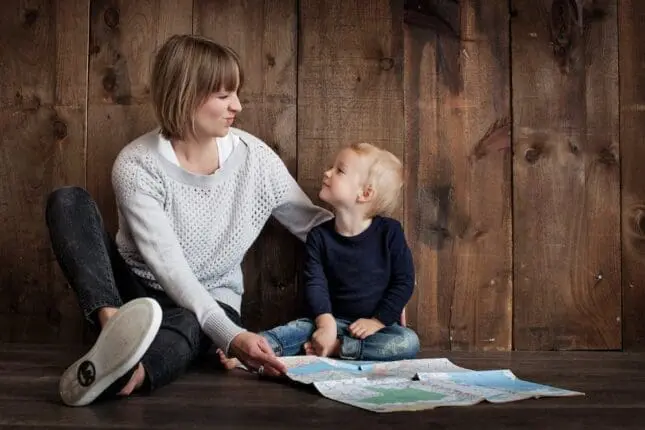The PACE attitude is a way of interacting with your child, especially around difficult topics or situations, that will help them feel less defensive and more connected and understood. When you use the PACE attitude, you express playfulness, acceptance, curiosity, and empathy.
Playfulness
Playfulness does not mean persistent teasing or sarcasm. Playfulness means bringing in a lighthearted, joyful, energetic, and silly energy to your interactions with your child. It can sometimes mean winking or walking in a funny way, or making a silly sound when you are imitating something humorous, absurd, or ironic that you experience in day-to-day life. Playfulness has an upbeat, sometimes irreverent, sometimes self- deprecating tone that helps to dissipate tension and create moments of connection. Being playful or finding humor shows your child that life is not always serious, that you don’t take yourself too seriously, and that you can find humor and pleasure in the little things in life.
While it’s not appropriate to be playful when your child is feeling very upset, being humorous or playful when your child is mildly upset can divert their attention and steer them toward a lighter tone. It can surprise them and give them a reset. For instance, if your child is upset because they’re hungry and want a sugary treat, you might respond in a silly, Cookie Monster voice: “Yummy yum yum—I’ve got the munchies too!
Let’s find something that will give us more energy to play!”
Acceptance
Acceptance means showing that you acknowledge and flow with what your child is saying, wishing, or feeling. You show acceptance by reacting without judgment, shock, or dismay at what they are expressing.
This attitude of acceptance does not mean condoning or accepting misbehavior or not providing limits. You can have strong limits and consequences and still accept the intention underneath your child’s misbehavior.
For example, say you receive a call from school that your daughter hit another student when they got into an argument on the playground. When you ask your daughter to tell you about it, she says, “I hate that girl! She deserved to get hit because she knocked my block tower down on purpose.” Responding with acceptance means saying something like “Wow, you felt really strongly about that” or “Thanks for telling me what was happening to you at the time.” Your words in no way imply that it is okay to hit. It is simply a way to open a conversation about a difficult topic without shutting down your child and getting into an argument. Remember that there will be time later to clarify your expectations or to give a consequence.
Some other general acceptance statements could be:
- Thanks for telling me what’s on your mind.
- I could tell that was important for you to express.
- I get it.
- I hear you.
- I got you.
- I can understand what you are saying.
- I didn’t know you felt that way before.
- I understand that you don’t need my help with this.
- I hear you saying you don’t want to talk about this.
- I have definitely seen you being able to handle this on your own.
- From hearing your story, I can see why you feel that way.
Empathy
Empathy means making your child feel like you truly get it, like you can feel their underlying feelings and see things from their point of view. This is demonstrated not only through your words but also through your facial expressions, tone of voice, and body posture. By showing your child that you are willing to put yourself in their shoes, you allow them to feel that they are not alone with their distress. Even if their feelings are big and overwhelming, you are showing that their feelings are not too much for you to handle.
Showing empathy can be difficult to do, especially if your child is expressing anger and disappointment toward you. However, in these circumstances, it’s even more important to try to convey empathy for your child’s experience. Continuing our example of your daughter hitting her classmate and then telling you, “I hate that girl! She deserved to get hit because she knocked my block tower down on purpose,” an empathic statement to this might be “Wow, that must have been so frustrating for you! You worked hard on the tower, and then your classmate knocked it down. And it felt like she did it on purpose!”
Here are some other general examples of empathy:
- That must be hard.
- I would be sad/mad/disappointed, too, if that happened to me.
- You’ve had to do this on your own for so long.
- Wow, so you have been dealing with a lot of difficult things.
- It must be really tough for you to handle all of this on your own.
- It must be hard for you to talk about this with me.
- Telling your story is never easy.
- You must be working really hard to cope on your own.
You can also express empathy through tones and sounds like ooh, wow, jeez, ah, and uh-huh.
Curiousity
Expressing curiosity with your child means asking questions that demonstrate that you truly wish to understand what is on their mind, how they see the world, and what their perspective is. It is not an interrogation or a quiz on how they could have handled the situation differently. It is a wondering aloud of what it would be like to be them in this situation.
True curiosity is demonstrated most strongly by your tone of voice. For the previous situation, an example of a true curiosity question would be “I wonder what made you so very upset that you lashed out at your classmate?” This is said in a wondering tone, with an upward inflection at the end of the question to demonstrate true interest. Contrast that with the tone of “Why did you do that?!” The latter typically sounds accusatory, demanding, and angry. The difference between curiosity and accusation is often in the way you say it. If your voice is not relaxed, or if your face and body are tense, then your child will feel the judgment, even if you use the so-called right words.
By being truly curious, you will help your child reflect on what they feel inside—what they think, believe, wish, and want. This is so valuable because when a child is aware of their thoughts and motives, it helps them feel like they know who they are on the inside. This knowledge guides them toward making decisions in the future that are in harmony with their goals and identity.
Other examples of curiosity include:
- Have you felt that way for a long time?
- What is it like?
- If there were one thing you would want me to understand about this situation, what would it be?
- Have you been in this situation before?
- Did anything ever help you to make things better about this problem?
- What could I do to help you get through this?
- What do you think the other person in this situation (your child’s classmate, teacher, friend, sibling, etc.) believes is the problem?
- I wonder if you feel angry and unheard by being made to come to therapy?
- Do you have any ideas about why we’re here in therapy together?
After you express a PACEful attitude, it is important to avoid giving long lectures or advice. It’s also important to avoid sliding into an argument. Listen and consider what your child has said. If you need to make a decision on how to handle the situation or give a consequence, it’s best to state it matter-of-factly.
Reprinted with permission from INTEGRATIVE ATTACHMENT FAMILY THERAPY by Dafna Lender with Molly Gage, published by PESI Publishing. © 2023 Dafna Lender and Molly Gage
Photo by Pixabay from Pexels
Dafna Lender
Dafna Lender, LCSW, is an international trainer and supervisor for practitioners who work with children and families. She is a certified trainer and supervisor/consultant in both Theraplay and Dyadic Developmental Psychotherapy (DDP). Dafna’s expertise is drawn from 25 years of working with families with attachment in many settings: at-risk after school programs, therapeutic foster care, in-home crisis stabilization, residential care and private practice. Dafna’s style, whether as a therapist or teacher, is combining the light-hearted with the profound by bringing a playful, intense and passionate presence to every encounter. Dafna is the co-author of Theraplay: The Practitioner’s Guide (2020). She teaches and supervises clinicians in 15 countries in 3 languages: English, Hebrew and French. Visit her website.













